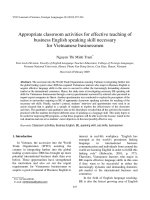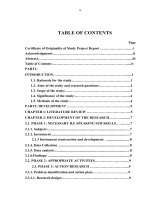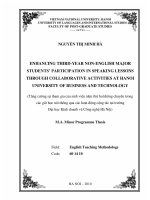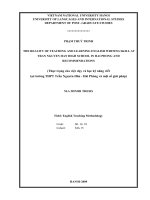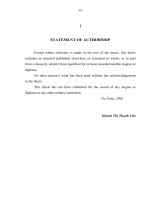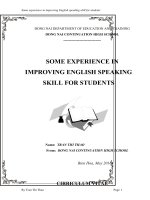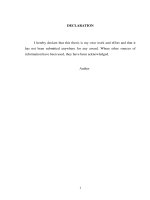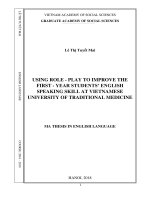Appropriate classroom activities for effective teaching of business English speaking skill necessary for Vietnamese businessmen = Những hoạt động trên lớp t
Bạn đang xem bản rút gọn của tài liệu. Xem và tải ngay bản đầy đủ của tài liệu tại đây (666.47 KB, 42 trang )
iv
TABLE OF CONTENTS
Page
Certificate of Originality of Study Project Report …………………….…i
Acknowledgments…………………………………………………….… ii
Abstract………………………………………………………… ……… iii
Table of Contents …………………………………………………… iv
PART1:
INTRODUCTION……………………………………………………… 1
1.1. Rationale for the study ……………………………………….…1
1.2. Aims of the study and research questions:…………………… 2
1.3. Scope of the study:…………………………………………… 3
1.4. Significance of the study:…………………………………….… 4
1.5. Methods of the study:………………………………………… 4
PART2: DEVELOPMENT …………………………………………… 5
CHAPTER 1: LITERATURE REVIEW ……………………………… 5
CHAPTER 2: DEVELOPMENT OF THE RESEARCH………… 7
2.1. PHASE 1: NECESSARY B.E SPEAKING SUB SKILLS……… 7
2.1.1. Subjects: 7
2.1.2. Instrument 7
2.1.3 Instrument construction and development: 8
2.1.4. Data Collection 8
2.1.5. Data analysis 8
2.1.6.Findings: 8
2.2. PHASE 2: APPROPRIATE ACTIVITIES……………………… 9
2.3. PHASE 3: ACTION RESEARCH ………………………… 9
2.3.1. Problem identification and action plan:…………………………9
2.3.1.1. Research design:…………………………………………………9
v
2.3.1.2. Research Sample …………………………………… ….10
2.3.1.3. Setting of the study: ……………………………………… 10
2.3.1.4. Design of the activities: …………………………… … 11
2.3.2. Methodology: …………………………………….……… 11
CHAPTER 3: FINDINGS OF ACTION RESEARCH,
IMPLICATIONS AND FUTURE ACTION …………….……… 11
3.1. Summary of findings:…………………………… … … 11
3.2. Implications and future action: ………………………… 12
PART 3: CONCLUSION………… …………………………… ….13
3.1. Conclusions ………………………… ……………….… 13
3.2. Summary of implications ……………………………… ….14
3.3. Limitations of the research and suggestions for further
study………………………………………………………………… 15
REFERENCES…………………………………………………… I
vi
LIST OF ABBREVIATIONS
BE
Business English
EAP
English for Academic Purpose
EBP
English for Business Purpose
EFL
English as a Foreign Language
EGAP
English for General Academic Purpose
EOP
English for Occupational Purpose
ESAP
English for Specific Academic Purpose
NEU
National Economics University
FTU
Foreign Trade University
TU
Trade University
BAU
Business and Administration University
1
PART1: INTRODUCTION
1.1. Rationale for the study:
In Vietnam, the accession into the World Trade Organization (WTO)
assisting the country in integrating further into the global trading system
since 2006 has brought up more potential international business deals than
ever before. These opportunities have strengthened the motivation and also
set out the urgent requirements for Vietnamese businessmen to acquire a
good command of Business English to interact in real-life workplace.
“English has emerged as the world’s prominent linking language in
international business communication and individuals from around the world
are learning English in order to fulfill this linking role” (Babcocks, 2001, p.
377). Therefore, Vietnamese learners who major in BE require effective
language skills in this area if they want to be successful in either the
increasingly dynamic and demanding job market or the international business
and commerce.
According to Council of Europe (2007), the language learning is
considered to be the most necessary when language needs are identified at the
future work place. Specifically, Stapp (1994) suggests that for effective
teaching and learning in a BE course, the first principle is to select teaching
and learning materials that reflect the needs of the target workplace so that
learners can reach qualification that helps them to be prepared for a career in
business. The second principle is to devise and /or choose the appropriate
activities that will promote learning the skill.
In fact, the Department of Business English, National Economics
University (NEU) is going to reform their content and the methods of
speaking course for students of BE starting from school year 2010-2011 so
2
that it can meet students’ future job requirements. However, ESP teachers at
the Department have had no recent research available investigating about the
requirements of the real workplace in Vietnamese context to decide what
should be the focus of a course on BE speaking while BE speaking skill is
defined in relation to some core business performance areas consisting of
various sub-skills according to Dudley-Evans and John (1996). The
researcher is assigned to carry out the survey investigating which BE
speaking sub skills are necessary for Vietnamese businessmen. Besides, how
these sub-skills are taught effectively is a major concern. The teachers of BE
Department at NEU usually wonder what activities to choose for a specific
time of the course.
Therefore, the rationale for choosing to investigate this issue lies in the
necessity of teaching and learning for real communication; and also in the
importance of applying appropriately the “how” in teaching BE speaking
skill through classroom activities.
For all these reasons that the researcher hope that after the BE
speaking sub-skills that are necessary for Vietnamese businessmen in their
workplace are examined and appropriate classroom activities suggested by
Vietnamese teachers at university level for teaching those sub skills are
investigated, the effectiveness of the mostly suggested activities will be
successfully dealt with in an action research.
1.2. Aims of the study and research questions:
This current study is aimed at developing BE programs, so that these
programs will be able to provide lessons that are relevant to the real
situations and can serve students’ career objectives in the targeted workplace.
Hence the specific following goals are expected to be accomplished in
undertaking the current study. First, the study only aims at the BE speaking
3
skill necessary for Vietnamese businessmen. Hence, the BE speaking sub-
skills often used at work by businessmen in Vietnam will be investigated.
Second, appropriate activities mostly suggested by teachers from Department
of BE at university level will be examined. Third, by an action research I
would like to find out how effective are the mostly suggested activities in
teaching speaking skill. The aim is to improve students’ BE ability in order to
speak more fluently, accurately and interactively with greater confidence in
the professional world dominated by English. Therefore, the research
questions that the present study seeks to answer are:
1. What sub-skills in BE speaking are necessary for Vietnamese
businessmen?
2. What kinds of classroom speaking activities are appropriate for
teaching these sub skills?
3. How effective are the speaking activities in helping students develop
BE speaking skill?
1.3. Scope of the study:
The present study only investigated the BE speaking skill that is
necessary for Vietnamese businessmen so it focused on the often used sub-
skills in the BE speaking in the first questionnaire to answer the first research
question. In addition, the subjects for the investigation about the often used
sub-skills of BE speaking skill in the first questionnaire are sales personnel in
import-export companies in Hanoi who have chances of more frequent
communication with foreigners in English and who are required to be
competent in BE communication (Ministry of Industry and Trade, 2009).
Third, the subjects of the second questionnaire are only the 1
st
and 2
nd
year
teachers of Department of BE in four universities majoring in business in
Vietnam including National Economics University, Foreign Trade University,
4
Trade University, and Business and Administration University. Fourth, the
study only focused on investigating classroom activities that were mostly
suggested by teachers from Department of BE at university level. Its findings
would not be necessarily generalized to all activities suggested by the
subjects. Finally, the action research was conducted with a small number of
students at intermediate level of the second year at the Department of
Business English, National Economics University to explore the
effectiveness of the mostly suggested classroom activities.
1.4. Significance of the study:
In decades of offering ESP courses in Vietnam, only few research
studies have been conducted in Vietnamese context. Among those, there is
too little research available to help to define, and to strengthen course focus
as well as activities organization. It is hoped that this study will be able to fill
a few gaps and lead to further research in the area.
1.5. Methods of the study:
In this study, the researcher used mixed methods. With an aim to
support the research with reliable and valid data, qualitative approach was
used together with quantitative one in three phases of the study.
In phase 1, a survey questionnaire was conducted among selected sales
personnel in import-export companies in Hanoi who have chances of more
frequent communication with foreigners in English to explore the sub-skills
of BE speaking often used by Vietnamese businessmen.
In phase 2, another survey questionnaire was conducted on the 1
st
and
2
nd
year teachers of Departments of BE in four universities majoring in
business in Vietnam including NEU, FTU, TU, BAU to investigate the
5
classroom speaking activities that are appropriate for teaching of the sub
skills.
In phase 3, an action research was applied to a sample of students at
intermediate level of the second year at the Department of Business English,
NEU to explore the effectiveness of the suggested classroom activities. The
data collection tools in this phase included teacher’s journal, students’
interview and questionnaire.
6
PART 2: DEVELOPMENT
CHAPTER 1: LITERATURE REVIEW
In this chapter, related literature on ESP, BE, needs analysis, teaching
BE, CEFR, BE speaking skill, classroom activities to develop speaking skill
has been reviewed to set up the theoretical framework for the current study.
English for Specific Purposes (ESP) has become one of the most
prominent areas of teaching English as a foreign language today. It “requires
the careful research and design of pedagogical materials and activities for an
identifiable group of adult learners within a specific learning context” (Johns
and Dudley-Evans, 1991) and is “designed to meet specified needs of the
learners” (Strevens, 1988).
BE can be seen as a branch of ESP. “BE is difficult to define and limit
in a linguistic term (Evans and St. John, 1998, cited by Donna, 2000, p. 102).
The term is part of ESP (Donna, 2000). According to Jones and Alexander
(1989), BE is not a special language. It is simply English used in business
situations. This is probably the working definition of BE used in the practical
work of this study.
Dudley-Evans and John (1996) claim that needs analysis is a defining
feature of ESP. In the area of BE, where many courses are tailor-made to
meet participants’ needs, it has a vital role. Need analysis may indeed be
even more fundamental to BE than to English for Science and Technology, as
learners’ needs may vary much more. Dudley-Evans and John (1998) define
needs in terms of "target needs”, meaning what the learner needs to do in the
target situation.
In the Project for teaching and learning foreign languages in the
national education system of Vietnam to 2020 approved by the Prime
Minister in 2008, CEFR is selected as the standards for language teaching in
7
Vietnam. The Common European Framework of Reference for Languages
(CEFR) was put together by the Council of Europe in Europe. Therefore,
CEFR is also applied as a framework of assessing and teaching BE speaking
skill for Vietnamese learners in this study. CEFR gives qualitative aspects of
spoken language use with reference to vocabulary range, pronunciation,
accuracy, fluency and interaction. The action research will be done with
students of Level B1 and B2.
Dudley-Evans and John (1996) note that the BE speaking skill is
defined primarily in relation to core BE speaking performance areas such as
taking part in meetings, giving presentations, socializing and negotiating.
The following figure illustrates the components of the core BE speaking
performance areas.
Socializing
skills
Negotiation
skills
Meeting
skills
Presentation
skills
Sub skills:
greetings, making
invitations,
thanking, 1
st
conversations,
apologizing,
exchanging
information,
telephoning
Sub skills:
relationship
building,
agree
procedure,
bargaining,
settling and
concluding
Sub skills:
holding and
ending a
meeting,
summarizing,
interrupting,
dealing with
arguments
Sub skills:
starting and
concluding
presentation,
describing products
or process,
presenting visuals,
analyzing business
trends.
Core BE speaking
performance
areas
8
Figure 2: Core BE speaking performance areas and sub skills (adapted
from Dudley-Evans and John (1997, p. 36))
Speaking activity in the classroom is defined as “an important
component of a language course” developing learner´s ability to express
themselves through speech (Council of Europe, 2007). According to
Thornbury (2005), classroom speaking activities are considered to be
appropriate for effective teaching when they can ultimately help students
improve their speaking skill. Speaking activities that are outlined in the rest of
this chapter attempt to provide and maximize the effectiveness of the
speaking learning processes (Thornbury, 2005): Using noticing-the-gap,
Acting from a Script, Questionnaires, Information Gap, Jigsaw puzzle, Card
game, Guessing game, Discussion, Dialogue, Simulation, Role-play, Drama.
CHAPTER 2: DEVELOPMENT OF THE RESEARCH
2.1. PHASE 1: NECESSARY B.E SPEAKING SUB SKILLS
This phase is aimed at examining the BE speaking sub skills often used
at work by businessmen to answer the first question research: “What sub-
skills in BE speaking are necessary for Vietnamese businessmen?”
2.1.1. Subjects:
Businessmen in 318 import-export companies in Hanoi Capital were
selected from the Annual Report by Ministry of Industry and Trade (2009).
According to the Table determining sample size from a given population
constructed by Krejcie & Morgan (1970), the determined number of the
subjects was 175 (p. 608).
2.1.2. Instrument
9
The questionnaire was used to collect the data for the study. It was
constructed in rating form. The questionnaire consisted of the following two
parts:
Part 1 was the lists of the BE speaking sub skills found in published
materials mentioned in the literature review.
Part 2 was the open-ended section for suggestions on the sub skills the
subjects mostly used at work.
2.1.3. Instrument construction and development:
Step 1: Pilot study: The initial questionnaire was edited for the pilot
study and tried out with 10 businessmen representatives.
Step 2: Questionnaire revised: On the basis of the pilot subjects’
responses, the questionnaire was later revised using the subjects’ suggestions
to ensure that it really addressed the research question.
Step 3: Data gathering: The revised questionnaire was used to gather
the data.
2.1.4. Data Collection
The data collection was conducted in August, 2009. The questionnaire
was conducted in the workplace where the subjects normally performed their
jobs. The steps in collecting the data are as follows:
Step 1: The researcher mailed 200 questionnaires to the subjects. The
reason for mailing 200 questionnaires (over the study’s sample size of 175)
was to prepare for some questionnaires not to be returned.
Step 2: After the deadline, the researcher received 178 returned
questionnaires. All of these returned questionnaires were used in later
analysis.
10
2.1.5. Data analysis
For the answer to part 1 of the questionnaire, frequency, percentage,
arithmetic mean were used to find out the BE speaking sub skills often used
at work by the subjects. For the answer to part 2 of the survey, percentage of
the subjects was used to find out the BE speaking sub skills frequently used
at work recommended by the subjects.
2.1.6. Findings: The three most necessary BE sub skills for Vietnamese
businessmen were exchanging information, telephoning and bargaining.
11
2.2. PHASE 2: APPROPRIATE ACTIVITIES
This second phase is aimed at examining the appropriate activities for
teaching the three BE speaking sub skills mostly used at work by
businessmen to answer the second question research: “What kinds of speaking
activities are appropriate for teaching these sub skills?”. The subjects were
83 teachers of the 1
st
and 2
nd
year of Department of BE in four universities
major in business in Vietnam including NEU, FTU, TU, BAU. They were
asked to complete the questionnaire by ticking the appropriate activities that
they experienced in closed questions and recommending more in open
questions.
Findings: discussion, guessing game, role play, and information gap
for teaching exchanging information; card game, jigsaw puzzle and role play
for teaching telephoning; and using noticing the gap, information gap, and
simulation for teaching bargaining were mostly considered appropriate by
more than 65% of the subjects (Burns et al., 2003).
2.3. PHASE 3: ACTION RESEARCH
2.3.1. Problem identification and action plan:
2.3.1.1. Research design:
Action research:
Action research identified as “the systematic collection and analysis of
data” was chosen in the current study (Wallace, 2001). First, action research
is the more suitable research methodology because the core purpose of the
study is to determine “the improvement of some aspect of professional
practice” in teaching speaking (Wallace, 1998, p.18). Second, action research
is often undertaken in a university setting and refers to a disciplined inquiry
done by the teacher with the intent that the research will inform and change
her practices in the future, or can help not only the teacher herself but also
12
her colleagues (Ferrance, 2000, p. 9). Third, action research is mostly
appropriate for this study because it involves “small-scale intervention” when
specific problems are identified; specific actions are implemented to bring
about the changes and solutions to solve the problems (Nunan, 2005).
Finally, the context of the research can satisfy the requirement of doing an
action research when teachers and students can collaborate with each other to
reflect on the effectiveness of the classroom activities. In brief, the action
research approach is carefully chosen for and applied in the study with a hope
to find a way to determine effectiveness of actions taken in teaching to
improve the BE program.
Mixed methods
According to Johnson et al. (2007), mixed-methods include both
quantitative and qualitative features in the design, data collection and
analysis when one single method cannot provide them with various
dimensions of the research problem (p. 112).
2.3.1.2. Research Sample
The research was conducted with 25 students at Pre- Intermediate level
of the second year at the Department of Business English, National
Economics University research in the second term of the school year 2009-
2010 for my action research.
2.3.1.3. Setting of the study:
Department of Business English - NEU was first established in the
school year 2006-2007 with an aim to produce dynamic businessmen with
major in both English and economics meeting the demand of the fast-
growing country in the era of economic globalization and informatization
13
Because of its outstanding significance, the teaching of the speaking
skill in the Department of Business English forms for itself a unique set of
requirements. They must be capable of improving students’ accuracy
vocabulary range, pronunciation, fluency, accuracy and interactive
communication (Council of Europe, 2007). As a result, an action research is
called for to investigate how effective the activities are for improving
students’ BE speaking skill.
2.3.1.5. Design of the activities:
The action research was carried out in second semester of the school
year 2009-2010. The course of action research consists of 10 lessons with
each activity per lesson. One lesson lasts for 45 minutes. All the investigated
activities are discussion, communication games, role play, and information
gap for teaching exchanging information; communication games and role
play for teaching telephoning; and using noticing the gap, information gap,
and simulation for teaching bargaining.
2.3.2. Methodology :
Research question:
The action research seeks to find answers to the question: “How
effective are the speaking activities in helping students develop BE speaking
skill?”
Methods of data collection:
The research was done with the help of the following instruments
+
Teacher’s journal
Survey
Interview
Questionnaire
14
CHAPTER 3: FINDINGS OF ACTION RESEARCH,
IMPLICATIONS AND FUTURE ACTION
3.1. Summary of findings:
All the activities the teacher practised with the students were useful
and contributive at different levels. In the lesson of exchanging information,
information gap activity helps students have an excellent interaction and
pronunciation, while role play improves student’s grammar and
pronunciation. Both guessing game and rating activity are good for their
fluency with excellent use of discourse markers. For effective teaching of
telephoning, all of the investigated activities- card game, jigsaw puzzle and
role play develop students’ grammar, wider range of vocabulary and
therefore pronunciation of new words. However, jigsaw puzzle is obviously
more successful in improving students’ fluency with appropriate length and
relevant contribution. All the activities for teaching bargaining- information
gap, using noticing-the-gap, and simulation are appropriate for students’
development in grammar and vocabulary with new and useful terms.
Nevertheless, noticing-the-gap, and simulation are excellent in helping their
fluency and interactive communication.
Reflection: Different activities in practicing BE speaking in the classes which
are interactive and interesting won the appreciation from both teachers and
students.
3.2. Implications and future action:
In teaching exchanging information, to engage students’ attention in
speaking classes, and motivate them to be active, it is advisable to arrange
students to have group discussion and instruct them clearly the rules and
requirements of the discussion. For this activity, teacher should encourage
15
students to build up a collection of proverbs and sayings to stimulate
socializing and to be more persuasive in presenting and rebutting arguments
to discuss information (Thornbury, 2005).
For effective teaching of telephoning skills, vivid and inspiring
activities should be applied because students need to use their imagination
when they can’t see others on the phone and also because telephoning have
highly standard etiquettes which are quite dry (Hadfield, 1990). Thus
activities with visual tools such as card game or jigsaw puzzle can arouse
students’ interests and also provide them support with emerging language
skills.
In terms of teaching bargaining in negotiation, it is recommended that,
technology can enhance negotiation learning because it allows analysis and
retrieval of raw data on negotiation experience, minimising students’
defensiveness and resistance to improvement (Pilbeam et al., 1992). It is
necessary to use videotaping, such as using video extracts from movies to
assist review, reflection and assessment or use discussion boards and other
techniques to assist reflection and class discussion. Besides, it is advisable to
use simulations to consolidate learning. Simulations help integrate
negotiation theory and hard skills. Besides, they are a useful way to unfreeze
past practice while also teaching new skills for dealing with people in
difficult situations (Fisher, 1981). To teach bargaining effectively requires a
teaching strategy which combines simulations with other games, cases and
readings; to layer or add on complexity one step at a time; two-party
negotiation; constant reflection to draw out bargaining lessons.
PART 3: CONCLUSION
3.1. Conclusions:
16
With a view to investigate appropriate classroom activities for
effective teaching of BE speaking skill necessary for Vietnamese
businessmen, the study was conducted to find out the sub-skills mostly used
at work by Vietnamese businessmen, and to look into possible influence of
classroom activities on the outcome of speaking in those sub skills for 2
nd
year students in DBE, NEU.
After the survey questionnaire phase was done, the BE speaking sub-
skills often used at work by Vietnamese businessmen were found to be
exchanging information, telephoning, and bidding bargaining. In the next
phase, another survey questionnaire was conducted to find out the kind of
speaking activities which are suggested by the BE teachers to be appropriate
for effective teaching of these sub skills. The findings of appropriate
activities suggested for teaching of exchanging information were guessing
game, rating activity, translation, definition, role-play and discussion; for
teaching of telephoning were card game, jigsaw puzzle and role-play; and
finally for teaching of bargaining were information gap, using noticing-the-
gap and simulation.
The action research was focused in the third phase to investigate how
effective the speaking activities are in developing students’ fluency,
accuracy, and interactive communication. However, all the activities the
teacher practised with the students were useful and contributive and all of
them developed different areas of speaking as a language skill.
3.2. Summary of implications:
In order to use appropriate classroom activities for effective teaching of
exchanging information, telephoning, and bargaining, it is recommended to
put the following suggestions into consideration. First, in teaching exchanging
information, to engage students’ attention in speaking classes, and motivate
17
them to be active, it is advisable to arrange students to have group discussion.
The teacher should encourage students to build up a collection of proverbs
and sayings to discuss information. For effective teaching of telephoning
skills, vivid and inspiring activities such as card game or jigsaw puzzle with
visual tools should be applied. With the activity role play the teacher need to
put students' chairs back to back approximate a telephone situation. In terms
of teaching bargaining (negotiation), it is necessary to use videotaping, for
example, to assist review, reflection and assessment or use discussion boards
and other techniques to assist reflection and class discussion. Finally, the
teacher should combine simulations with other games, cases and readings;
layer or add on complexity one step at a time; and encourage constant
reflection to draw out bargaining lessons.
3.3. Limitations of the research and suggestions for further study
First of all, the objectivity of the action research may be questioned as
the researcher is also the teacher in the research. However, as claimed by
Hoyle (1972, p. 24, quoted in Stenhouse 1988, p. 144, cited in Rea-Dickins
and Germaine, 1992:66), “Ultimately, it is the teacher who has to
operationalize on innovation at the classroom level”. Being an insider helps
the researcher with a thorough and insightful understanding of the use of
activities in teaching BE speaking skill. Moreover, she uses interview and
questionnaires to ask for ideas of students studying the sub skills and
students’ checklist for more objective assessment and utilizes her self-report
to record ongoing features of effectiveness of the activities. The researcher
had her belief that the combination of both quantitative and qualitative
method would generate objective and good results in her research.
Second, the validity of the research would be better guaranteed if more
participants were involved in the action research. Nevertheless, the various
18
sources of information and different ways of collecting it can hopefully be a
good substitution for the limited number of participants in the research.
Hence, the researcher uses data triangulation and methodological
triangulation to make up for it.
The focus of the further study can be the teaching of BE speaking
according to student’s needs or the appropriate activities suggested by
students. However, due to the time matter, the researcher only focuses on the
most appropriate activities suggested by BE teachers for teaching the BE
speaking sub skills often used by Vietnamese businessmen. It is highly
recommended that further study on the issues raised to create a more perfect
design of curriculum and activities in BE speaking, should be given more
time.
I
APPENDICES
APPENDIX 1- INQUIRY LETTER
Master of Arts Program in English Methodology
Post graduate Studies
University of Languages and International Studies, VNU
August 31, 2009
Dear Sir/Madam, a
I am currently conducting a thesis for the Master of Arts Program in English Methodology at Post
graduate Studies - University of Languages and International Studies, VNU. My thesis title is
“Appropriate Classroom Speaking Activities for Effective Teaching of Business English Speaking
Skill Necessary for Vietnamese Businessmen”. This research needs your participation as partial
fulfillment of the thesis completion.
Your participation will involve the completion of the questionnaire. This questionnaire does not
request proprietary or sensitive information of any kinds, and no individual or company will ever
be mentioned in my work.
Your participation will provide benefits to the academic community. Thank you very much.
Sincerely yours,
Nguyen Thi Minh Tram
II
QUESTIONNAIRE 1
Please give some general information:
Gender: a. Male b. Female
How long have you been speaking Business English for your work?
Less than 3 years � 3-5 years � more than 5 years �
Your level of English:
a. Excellent (Advanced) d. Average/ fairly good (Pre-Intermediate)
b. Very good (Upper-Intermediate) e. Not good
c. Good (Intermediate) f. Other ideas (please specify)….
Below are the lists of business English speaking sub skills. Consider each item carefully
and check the frequency of using it.
Frequency of using business English speaking sub skills:
- Never used
- Rarely used (once a week)
- Normally used (once a day)
- Often used (twice or three times a day)
- Very often used (more than three times a day)
Part 1: The common skills found in the published materials:
How often do you use the following sub skills?
Tick the column with the heading that best reflects your frequency of using it:
Never
used
Rarely
used
Normally
used
Often
used
Very
often
used
1. Socializing
1.1. Greetings
III
1.2. First conversations
1.3. Making invitations
1.4. Exchanging information
1.5. Thanking
1.6. Apologizing
1.7. Telephoning
2. Presentations
2.1. Starting and concluding
presentation
2.2. presenting visuals
2.3. describing products or
processes
2.4. analyzing business trends
3. Meetings
3.1. holding and ending a
meeting
3.2. interrupting
3.3. summarizing
3.4. dealing with arguments
4. Negotiating
IV
4.1. Relationship building
4.2. Agree procedure
4.3. bargaining
4.4. settling and concluding
